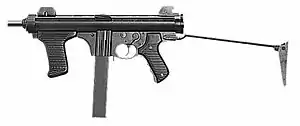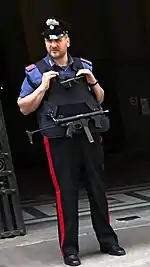Beretta M12
The Beretta Model 12 is a 9×19mm Parabellum caliber submachine gun designed by Beretta. The production started in 1962, the first users were the Italian Carabinieri, Italian State Police and the Guardia di Finanza even though in limited number, only in 1978 it was widely issued replacing the old Beretta MAB. In 1962 the Italian Army bought a limited number of Franchi LF57 submachine gun, judged better than the M12 but never issued to the troops, and only in 1992 the M12S2 variant was introduced also if in very limited number. The Italian Air Force, instead, bought many M12S and M12S2 for the airport security units. However the weapon had a higher initial success in the Arab countries and South America. Its debut in combat came during the Tet Offensive in 1968 when the US Marines guarding the U.S. embassy in Saigon repelled the assault by the Viet Cong using the Beretta M12. It is also used by various South American, African and Asian countries,[4] and made under licence in Brazil by Taurus, in Belgium by FN Herstal and in Indonesia by PT Pindad.
| Beretta Model 12 | |
|---|---|
 Beretta M12S displaying extended folding stock. | |
| Type | Submachine gun |
| Place of origin | Italy |
| Service history | |
| In service | 1959–present[1] |
| Used by | See Users |
| Wars | Vietnam War The Troubles Afghanistan wars Lebanese Civil War[2] Iran-Iraq War Libyan Civil War[3] |
| Production history | |
| Designer | Beretta |
| Designed | 1950–1959[1] |
| Manufacturer | Beretta, Taurus, Defence Industries Corporation, MAS, PT Pindad |
| Produced | 1959–present[1] |
| Variants | See Variants |
| Specifications | |
| Mass | Metal stock:
Wood stock:
|
| Length | Fixed stock: 660 mm (26.0 in)[1] Folding stock:
|
| Barrel length | 200 mm (7.9 in)[1] |
| Height | 180 mm (7.1 in) |
| Cartridge | 9×19mm Parabellum[1] |
| Action | Blowback[1] |
| Rate of fire | 550 rounds/min[1] |
| Muzzle velocity | 380 m/s (1,247 ft/s)[1] |
| Effective firing range | 100 to 200 m sight adjustments |
| Feed system | 20-, 32-, or 40-round detachable box magazine[1] |
| Sights | Two-position flip rear aperture, shrouded front post 285 mm (11.2 in) sight radius |
Development
In 1959, Beretta weapons designer Domenico Salza revisited an old project, the Armaguerra Cremona OG44 submachine gun, in order to make a new submachine gun to replace the old MAB model 1938. The Model 12 was the final production model, and was followed ten years later by the M12S with differences in the safety and other mechanics.
Design details
The Model 12 weighs 3.48 kilograms empty (about 3.820 kg loaded) and is 660 millimeters in length with stock extended (418 mm when retracted). Its short length is achieved by use of a barrel recessed into the bolt head, known as a telescoping bolt. This reduces length without reducing barrel length or bolt weight.[5] It fires from an open bolt and has a cyclic rate of fire of 550 rounds per minute.
The barrel and rifling are chromium-plated to prevent fouling. The bolt housing has grooves to allow bolt movement, even in extremely adverse conditions such as exposure to mud, dust, or sand.[6] The exterior surfaces of the firearm are finished with epoxy resin coating for protection against corrosion and damage.
The weapon has a selective-fire option allowing a choice of single shot or fully automatic fire.
The weapon has three safeties: a manual safety which blocks the trigger; an automatic safety on the rear grip which immobilizes the trigger and blocks the bolt in a closed position; and a safety on the cocking handle locking the bolt in case it does not retract sufficiently.
The weapon is provided with a front sight (adjustable for elevation and windage) and a rear sight with a two-position flip aperture (up to 100 m and up to 200 m).
The gun is equipped with a side folding stock, but is also seen rarely with a fixed stock.
20-, 32-, and 40-round box magazines were available for the original Model 12, which was chambered for the 9mm Parabellum cartridge.
Variants
The first variant was introduced, in limited number, at the end of the '60s for the Italian Navy special forces and is easily recognizable from the longer barrel, about one inch, and the presence of a birdcage-type flash suppressor. It has been replaced by the Heckler & Koch MP5.
The Model 12 was redesigned as the Beretta Model 12S in 1978. The Model 12s uses a 32-round box magazine, and is chambered for the 9×19 mm NATO cartridge.
A novel feature is the grip safety, which locks the trigger and the bolt in the closed position, thus safeguarding against accidental firing if the grip is not held firmly or if the gun is dropped. The safety and fire-selector switch, which in the original Model 12 were two separate push-pin button (with the fire-selector being a button that activated single-fire or burst fire whether it was pushed on the right side or the left side) have been re-engineered in a modern lever-type selector with three positions (S for "Sicura" or Safety, 1 for Single-fire, R for "Raffica" or Burst fire). The fixed firing pin on the face of the bolt can strike the primer only when the cartridge is chambered fully, and this also avoids accidental firing, according to its designers.
The PM12S was also designed with easy field-stripping and reassembly in mind, which has been simplified and can be accomplished without tools. It can be equipped with a suppressor, but this requires a slight modification of the barrel by a competent gunsmith.
Minus the suppressor and other optional features, the Beretta PM12S is made up of 84 discrete components.
The current version of the Beretta Model 12, is called the PM12-S2. In the mid-1980s the Italian Carabinieri, after a misfire accident, asked for a modification, in the form of a further safety device, which allowed both to keep the bolt of the weapon in half-cocked position and acted as an interceptor preventing accidental fire should the bolt or the firing pin suddenly disengage. This modification was implemented as a standard factory feature, and the denomination of the submachine gun changed to PM12-S2; this is the only Model 12 variant currently manufactured by Beretta.
Users



 Algeria[4]
Algeria[4] Bahrain[4]
Bahrain[4].svg.png.webp) Belgium Made under license by F.N. Herstal[4] (out of service)
Belgium Made under license by F.N. Herstal[4] (out of service) Brazil: Made under license by Taurus.[7][8] Standard submachine gun of the Brazilian Army where it is designated M972.[4][7]
Brazil: Made under license by Taurus.[7][8] Standard submachine gun of the Brazilian Army where it is designated M972.[4][7] Chile[4]
Chile[4] Costa Rica[4]
Costa Rica[4] Cuba PNR MININT [9]
Cuba PNR MININT [9] Egypt[4]
Egypt[4] France Used by police officers.[10]
France Used by police officers.[10] Gabon[4]
Gabon[4] Guatemala[4]
Guatemala[4] Guyana[4]
Guyana[4] Indonesia: Manufactured under license.[4][8] Known models made by Pindad consist of the PM1 and the PM1A1.[11]
Indonesia: Manufactured under license.[4][8] Known models made by Pindad consist of the PM1 and the PM1A1.[11] Iran[4]
Iran[4] Italy: It is used by all armed forces and police forces: the GIS and NOCS special groups,[12] the Carabinieri,[13] Italian Navy, Italian Air Force, Polizia di Stato, Guardia di Finanza, Polizia Penitenziaria and Corpo Forestale dello Stato.[14]
Italy: It is used by all armed forces and police forces: the GIS and NOCS special groups,[12] the Carabinieri,[13] Italian Navy, Italian Air Force, Polizia di Stato, Guardia di Finanza, Polizia Penitenziaria and Corpo Forestale dello Stato.[14] Libya[4]
Libya[4] Malta: Armed Forces of Malta.[15]
Malta: Armed Forces of Malta.[15] Nigeria[4]
Nigeria[4] Portugal[4]
Portugal[4] Saudi Arabia[4]
Saudi Arabia[4] Sudan[4]
Sudan[4] United States Central Intelligence Agency and some SWAT teams[4]
United States Central Intelligence Agency and some SWAT teams[4] Tunisia[4]
Tunisia[4] Vatican City[4]
Vatican City[4] Venezuela[4]
Venezuela[4] Provisional Irish Republican Army: Sent to the IRA by Libya, used in various ambushes.
Provisional Irish Republican Army: Sent to the IRA by Libya, used in various ambushes.
References
- Miller, David (2001). The Illustrated Directory of 20th Century Guns. Salamander Books Ltd. ISBN 1-84065-245-4.
- Katz, Sam; Russell, Lee E (25 Jul 1985). Armies in Lebanon 1982–84. Men-at-Arms 165. Osprey Publishing. p. 46. ISBN 9780850456028.
- Jenzen-Jones, N.R.; McCollum, Ian (April 2017). Small Arms Survey (ed.). Web Trafficking: Analysing the Online Trade of Small Arms and Light Weapons in Libya (PDF). Working Paper No. 26. p. 91. Archived (PDF) from the original on 2018-10-09. Retrieved 2018-08-30.
- Gander, Jerry (2002). Jane's Infantry Weapons 2002–2003. Jane's Information Group. pp. 214, 899–906. ISBN 0-7106-2434-4.
- Hogg, Ian; Weeks, John (2000). Military Small Arms of the 20th Century. Iola, Wisconsin: Krause Publications. p. 139. ISBN 0-87341-824-7.
- Long, Duncan (1986). Assault Pistols, Rifles, and Submachine Guns. Boulder, Colorado: Paladin Press. p. 17. ISBN 0-87364-353-4.
- "Archived copy". Archived from the original on 2007-10-11. Retrieved 2008-09-16.CS1 maint: archived copy as title (link)
- Diez, Octavio (2000). Armament and Technology: Handguns. Lema Publications, S.L. ISBN 84-8463-013-7.
- "Archived copy". Archived from the original on 2017-01-16. Retrieved 2017-01-14.CS1 maint: archived copy as title (link)
- Molinié, William (20 July 2015). "Les policiers bientôt mieux armés face à la menace terroriste et au grand banditisme". 20 minutes (in French). Archived from the original on 12 July 2018. Retrieved 31 August 2018.
- "Un repaso a las armas ligeras de Pindad" (in Spanish). ARMAS. Archived from the original on 2013-04-02. Retrieved 2010-07-05.
- Meyr, Eitan (January 6, 1999). "Special Weapons for Counter-terrorist Units". Jane's — Law Enforcement. Archived from the original on March 1, 2008. Retrieved 2009-09-26.
- The Carabinieri - Armament - Beretta M12 Archived April 14, 2010, at the Wayback Machine
- Italian Parliament, Session 46, report of the Minister of the Interior
- Ryder, Chris (2005). A special kind of courage: 321 EOD Squadron -- battling the bombers. Methuen. p. 228. ISBN 978-0-413-77223-7.
External links
| Wikimedia Commons has media related to: |
- Modern Firearms
- Video of operation on YouTube (in Japanese)
